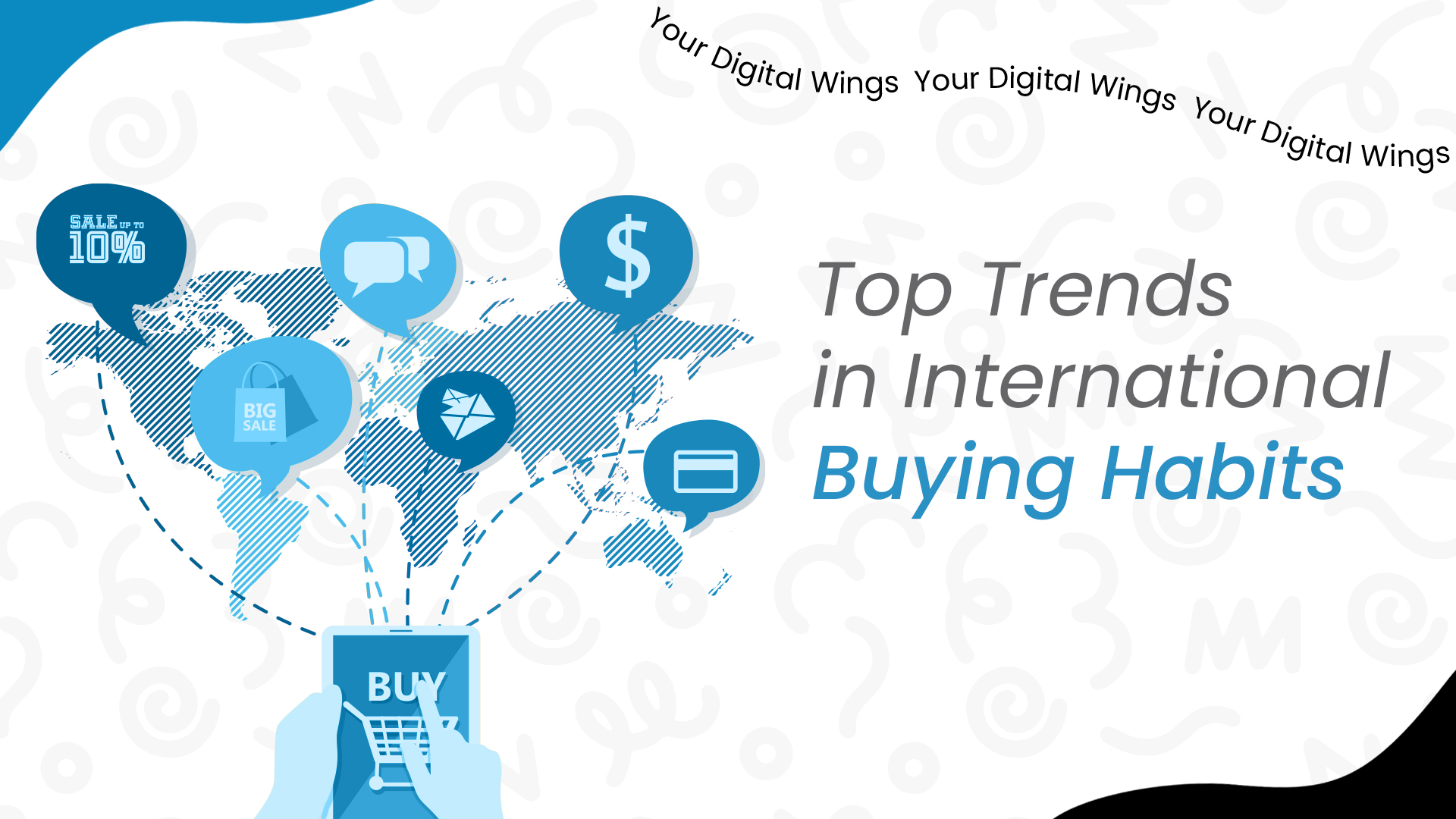Understanding international buying habits is key for businesses aiming to expand their reach to unblock globalized markets. The landscape of consumer behavior is continually evolving. Factors such as technology, cultural shifts, and economic conditions influence this landscape. Every individual has it’s buying style. Some like to purchase a product while keeping one eye on the price. Some like to buy for fun while others don’t buy without any bargain.
Every person with a different culture has different buying behavior. Culture follows trends and works as the lens through which the consumer looks at the product. The product remains the same, but the lens through which they look, i.e., culture, changes. Every product needs a specific marketing strategy. One person from a particular culture may find the product attractive and intriguing, but buying for others may be a sin.
1. Increased Focus on Sustainability,
One of the most prominent trends in international buying habits is the growing attention to sustainability. Consumers worldwide are becoming more environmentally conscious. They start seeking products and services that align with their values. This shift is obvious in the rising demand for eco-friendly products, sustainable packaging, and transparent business practices. Companies prioritizing sustainability will likely attract a loyal customer base and enhance their brand reputation.
As consumers become more environmentally conscious, businesses need to prioritize sustainability. This is important to meet market demands and build a positive brand reputation. Here are three steps to enhance your focus on sustainability:
- Implement Sustainable Practices
- Offer Sustainable Products and Services
- Engage and Educate Consumers
2. Digital and Social Media Influence
Digital platforms and social media pack a punch when it comes to global consumer trends and behavior. Instagram, TikTok, and Facebook are prime spots for folks to stumble upon fresh products and services. Influencers and user content? They’re the real MVPs in swaying what people buy. Companies gotta hop on these platforms to chat with their crowd, boost their brand, and rake in those sales. Social media’s got this knack for shifting customer habits in a snap – people snatch up what’s hot and jump on the bandwagon of following trends.
Digital and social media influence international buying habits by serving as essential tools for product discovery and research, enabling personalized advertising and targeting, and fostering brand loyalty and community through direct communication and content sharing. Businesses that leverage these platforms effectively can better connect with their audiences and drive global sales.
3. Health and Wellness Products
The global pandemic has heightened awareness around health and wellness. This leads to increased demand for products that promote well-being. Consumers prioritize their physical and mental health. They focus on seeking organic foods, fitness products, and mental health resources. This trend allows businesses to innovate and offer products that cater to the growing health-conscious market. Mental satisfaction is essential in everything. If you buy anything and you don’t feel happy after buying it, no matter how expensive you purchase it, it will affect your mental peace. It matters a lot if you buy anything at a low price, even if you are mentally satisfied after purchasing it.
As global awareness around health and wellness continues to grow, consumers increasingly prioritize products that promote their physical and mental well-being. This trend has psychological influences on consumer behavior. Here are three key points on how health and wellness products are influencing global consumer behavior:
- Rising Demand for Organic and Natural Products
- Growth of Functional Foods and Supplements
- Emphasis on Mental Health and Well-being
4. E-commerce and Online Shopping
E-commerce remains the main player in today’s retail scene. Everywhere worldwide, consumers rely on the Internet to make their purchases. Advancements such as augmented reality and virtual try-ons are improving the convenience of shopping at home, transforming ecommerce into a necessary part of every successful business. Ensuring your website offers smooth user experiences and safe payment options will be essential.
1. Global Reach and Accessibility:
- E-commerce platforms allow consumers to shop from anywhere in the world, breaking down geographical barriers. This global reach enables businesses to tap into new markets and expand their customer base internationally.
- Online shopping provides convenience and accessibility, making it easier for consumers to purchase products that may not be available locally.
2. Advanced Technology Enhancements:
- Technologies like augmented reality (AR) and virtual reality (VR) are enhancing the online shopping experience by allowing consumers to virtually try products before purchasing.
- Secure payment gateways and diverse payment options, including cryptocurrency, cater to international buyers’ preferences, ensuring smooth and trustworthy transactions.
3. Cross-border Shipping and Logistics:
- Improved logistics and shipping solutions have made cross-border e-commerce more efficient, reducing delivery times and costs.
- Businesses offer transparent shipping policies and tracking systems, which give international customers confidence in their purchases and ensure a positive shopping experience.
5. Personalization and Customized Experiences
Buyers crave unique experiences. They want businesses to cater to their likes and dislikes. Companies that deliver custom-fit services boost customer loyalty and sales. Tailored suggestions and bespoke items make buyers happy. Firms crunch numbers to grasp what folks want. They suggest stuff based on what you’ve clicked and bought before. This makes shopping more fun and relevant. People hunger for products that match their style.
From made-to-measure clothes to personalized gadgets, custom options help brands shine. They also make customers smile. Ad folks now zero in on specific groups. They craft messages that speak to you. These personal touches often lead to more clicks and buys. Intelligent chatbots lend a hand, helping you find just what you need. Cool features let you “try on” items or tweak products on the spot. Reward programs that match your shopping habits keep you coming back for more. Tailored incentives and exclusive offers for loyal customers enhance brand loyalty and long-term customer relationships.
6. Economic Factors and Price Sensitivity
Economic conditions definitely affect our spending habits. In times of inflation, currency fluctuation, and financial uncertainty, we find ourselves at the topmost level of price sensitivity, i.e., the Purchasing Power is at its minimum level. As a result, one hesitates to buy despite needing it. Pricing becomes most important for selling to consumers in such an environment. Thus, it is necessary to consider factors like pricing based on Value-for-Money, Competitiveness, Disc, and Flexible payment options when selling.
- Consumer Behavior: Economic instability and rising inflation make consumers more price-sensitive, prioritizing essential items and seeking value-for-money products.
- Business Strategy: Companies may need to adjust pricing strategies, offer discounts, or introduce budget-friendly product lines to attract cost-conscious consumers and maintain sales.
- Currency Fluctuations: Changes in exchange rates affect the affordability of products for international buyers, requiring businesses to monitor and adjust pricing to remain competitive.
- Purchasing Power: Variations in currency value impact the Socioeconomic impacts on the purchasing decision power of consumers in different regions, influencing their buying habits and demand for imported goods.
- Value Proposition: Highlighting the value proposition of products, such as quality, durability, and unique features, helps appeal to price-sensitive customers and justify higher prices.
- Flexible Payment Options: Offering installment plans, buy-now-pay-later (BNPL) services, or interest-free financing makes higher-priced items more accessible to budget-conscious consumers.
- Promotional Strategies: Strategic promotional campaigns during key shopping periods, along with exclusive discounts and rewards for loyal customers, can attract price-sensitive customers and encourage repeat purchases.
7. Cultural and Regional Preferences
Understanding cultural and regional preferences is very important for businesses operating in international markets. Customers’ buying behavior is driven by their culture, tradition, and locality. Companies must do complete market research to customize their products and marketing policies to suit different customers. For example, the flavors, packaging of the product, and its brand name might need alteration to meet the tastes and requirements of a particular region.
Conclusion
Companies must keep an eye on shifting global buying trends to excel in world markets. Success hinges on several key factors. Firms should push for eco-friendly practices. They need to harness the power of online and social platforms. Catering to health-conscious shoppers is a must. Businesses should fine-tune their online sales channels. Offering unique, tailored experiences can set them apart. Economic shifts demand attention. Respecting local customs is crucial. By adapting to these patterns, firms can boost customer joy, and fuels their growth. This approach paves the way for higher profits and market dominance.
FAQs
What are the major international buying habits to watch in 2024?
The major trends include a focus on sustainability, the influence of digital and social media, the demand for health and wellness products, the dominance of e-commerce, the need for personalization, sensitivity to economic factors, and the importance of cultural and regional preferences.
How can businesses adapt to these emerging trends?
Businesses can adapt by incorporating sustainable practices, engaging with customers on digital platforms, offering health-focused products, optimizing e-commerce experiences, providing personalized services, being mindful of economic conditions, and tailoring strategies to local cultures.
What impact do these trends have on global marketing strategies?
These trends necessitate a shift towards more sustainable, personalized, and culturally aware marketing strategies. Businesses must leverage digital tools and data analytics to understand consumer behavior and deliver targeted, relevant, and engaging marketing campaigns.

 United Arab Emirates
United Arab Emirates